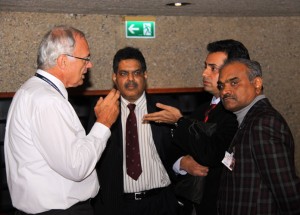The opportunity to attend INC5 was the most unique academic experience of my time at MIT so far. Not only was I exposed to the environmental policy-making process at the highest level, but I also got to travel overseas with an incredible group of people. I learned a ton, but here are my top four takeaways from Geneva:
Technical details don’t always matter:
Sitting in on the contact group on selected technical articles, I was surprised by how quickly we would sometimes reach the limits of technical knowledge in the room. I recall one exchange about fluorescent light bulbs. One country was advocating for an exemption of a certain type of bulbs, but when pressed on the issue, could not describe their actual use. In fact, no one in the room knew exactly what the new proposed text was referring to! It was clear that the delegate had received specific policy goals from her government, but didn’t have a complete grasp of the reasoning behind them. In the end the delegates came to a compromise concerning the technology, but I was very surprised that so much time was spent on something that no one in the room really understood.
Stamina counts:
Many important decisions were reached in the early hours of the final days of INC5, and the delegations that were present and making sure their voices were heard at that point often got their way. The ability to remain sharp, focused and tenacious throughout an exhausting week of negotiations is a big factor for whose policy view will be reflected in the text.
Compromises are reached behind closed doors:
As the week wore on it became clear that the breaks between formal meeting times, when delegates had the opportunity to meet bilaterally to discuss their positions, were when compromises were made. The large contact group meetings really only allowed delegations to lay out their positions, and to determine the areas of contention. Then, in the breaks, delegates were able to speak to one another informally in order to trade across issues silos, and come to agreeable compromise.
Capacity is a determinant of success:
George Orwell might have said of UNEP negotiations, “All states are equal, but some states are more equal than others.” Although every state has equal opportunity to voice their concerns in plenary and contact groups, there is a clear disparity in states’ abilities to effectively advocate for their policy interests. The USA, Canada, the EU, Norway, Switzerland, Japan and China routinely dominated conversations, and it is no fluke that these groups devoted significant human and financial resources to their INC5 delegations. This disparity of capacity became more evident as the week wore on. In some cases, when there were multiple contact groups working simultaneously, lower-capacity delegations could not afford to send the people in order to be represented at every discussion.
Reading back over these lessons, I recognize that they could be interpreted to deduce that I have a negative impression of the UNEP INC process. In reality, I feel quite the opposite. Although I now better understand the realities of the process, I am truly amazed at the way that so many parties with such diverse (and often conflicting) interests were able to come to an agreement. It is a slow, imperfect, and sometime torturous process, but in the end the parties were able to reach some kind of equilibrium on all the issues on the table. It might sound cheesy, but that gives me hope for the type of multi-lateral, global problems that the world will increasingly face in the future.












